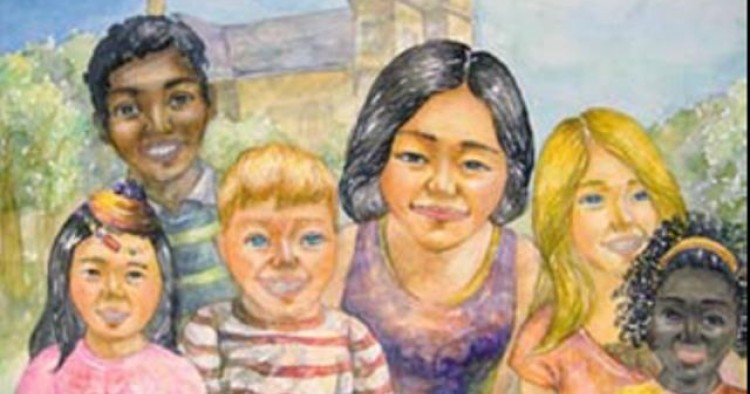Originally posted June 2011
I have been teaching for 18 years, but I do more than teach art, I teach children! I teach them through the vehicle of the visual arts. As head of the Visual Art Department at North Gwinnett High School, I always strive to push my students to think. My goal is to get them to think critically, creatively, and divergently as they work through their technical skills to create masterpieces. Several years ago, I received an e-mail from our Gwinnett County superintendant, Mr. Alvin Wilbanks. We rarely receive e-mails from the superintendant, so when he does contact us, we listen! He was advertising this awesome competition being hosted by the Istanbul Center, a state-wide art and essay competition about “The Alliance of Civilizations”! That was the kind of lesson I wanted to share with my students, one that made them think deeply.
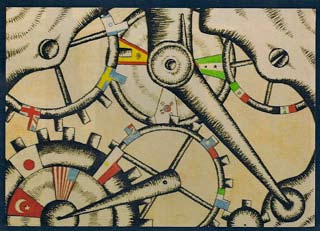 When I began to think about making this contest into a lesson that would become a part of my drawing and painting curriculum, I knew that I wanted kids to think and I wanted to “see” that thinking, it became a driving force of the success of the lesson. As I started the lesson, I wrote on the board, in large letters, “WHAT DOES EMPATHY LOOK LIKE” — or in the previous years, “WHAT DOES AN ALLIANCE OF CIVILIZATIONS LOOK LIKE”, or “WHO IS YOUR NEIGHBOR … REALLY, WHO is your NEIGHBOR”? Students began to brainstorm in their sketchbooks the visual answers to these questions. I used the guiding questions given to us by the Istanbul Center, but I went a bit further and had students visually tell their personal stories in regards to the theme at hand. I encouraged them to think beyond the obvious. They had to complete 10 beginning thumbnail sketches and then merge ideas to create 4 new ones based on their first sketches. As these ideas grew and expanded in depth, we again, asked the questions loudly.
When I began to think about making this contest into a lesson that would become a part of my drawing and painting curriculum, I knew that I wanted kids to think and I wanted to “see” that thinking, it became a driving force of the success of the lesson. As I started the lesson, I wrote on the board, in large letters, “WHAT DOES EMPATHY LOOK LIKE” — or in the previous years, “WHAT DOES AN ALLIANCE OF CIVILIZATIONS LOOK LIKE”, or “WHO IS YOUR NEIGHBOR … REALLY, WHO is your NEIGHBOR”? Students began to brainstorm in their sketchbooks the visual answers to these questions. I used the guiding questions given to us by the Istanbul Center, but I went a bit further and had students visually tell their personal stories in regards to the theme at hand. I encouraged them to think beyond the obvious. They had to complete 10 beginning thumbnail sketches and then merge ideas to create 4 new ones based on their first sketches. As these ideas grew and expanded in depth, we again, asked the questions loudly. 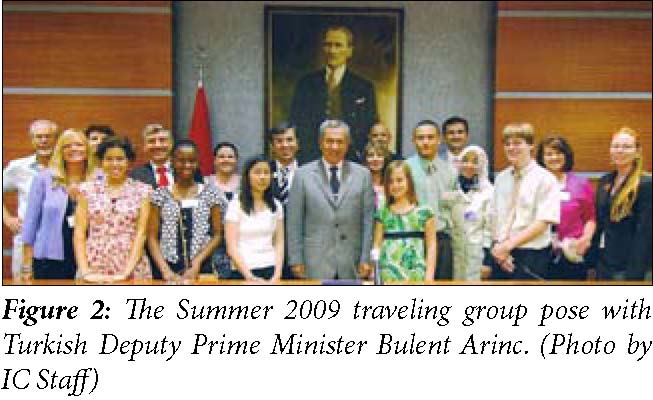 We then conducted group critiques, sharing ideas and exploring new symbols or words that could enforce the answers to the questions. Once students selected their final thumbnail sketch to enlarge, I allowed them to use the medium of their choice and create their pieces on any media they wanted (within the Istanbul Center’s guidelines).
We then conducted group critiques, sharing ideas and exploring new symbols or words that could enforce the answers to the questions. Once students selected their final thumbnail sketch to enlarge, I allowed them to use the medium of their choice and create their pieces on any media they wanted (within the Istanbul Center’s guidelines).
Most of my students in the drawing and painting class have learned the basic technical skills needed in traditional art making, at this point. They have been taught how to properly use graphite, charcoal, watercolor, acrylic, pen and ink, colored pencil, collage, etc. They were encouraged to utilize an array of media in their final pieces. As students began to work on their final artworks, they were excited with where their solutions to the problem had gone and were even more motivated that they had the tools to see the art come to fruition! I think they were also excited about having their art “judged” with a possibility to move forward in this state and now, regional competition. This gave them the extra push that not only gave us tremendously successful art, but also prepares them for Draw/Paint II and ultimately, their Advanced Placement art courses.
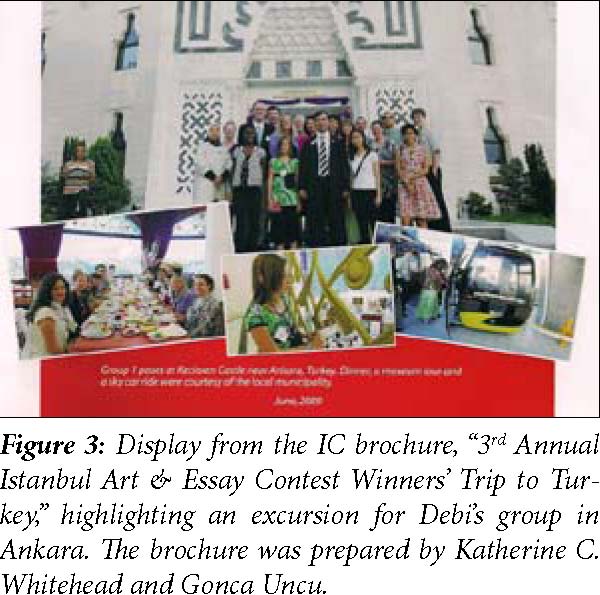 Our final “Istanbul Center” art exhibit is always well received in the school. Teachers, students and community members truly enjoy seeing the answers to the annual questions answered so creatively and with such attention to technique. This has become, without a doubt, one of my most successful Art II lessons.
Our final “Istanbul Center” art exhibit is always well received in the school. Teachers, students and community members truly enjoy seeing the answers to the annual questions answered so creatively and with such attention to technique. This has become, without a doubt, one of my most successful Art II lessons.
For the 2009 contest, our school selected 18 of the 60 to submit their works. Several months later, the results were released: We had garnered 4 state honorable mention awards and a 2nd place state award, which meant that Jenni Paek and I would be going to Turkey for a 10-day summer excursion!
And what an experience that was! Spending ten days in Turkey with art and essay student winners, top-notch visual art and language arts teachers and being immersed into a culture that very few of us knew anything about, was quite literally, life changing! From Istanbul, to Ankara, to Izmir, and back to Istanbul, from being featured on the “Today Show,” to meeting host families, to experiencing the every day kindness of the people of Turkey, I left with a changed heart! And changed hearts create changed minds! What a powerful lesson for our students in Georgia!
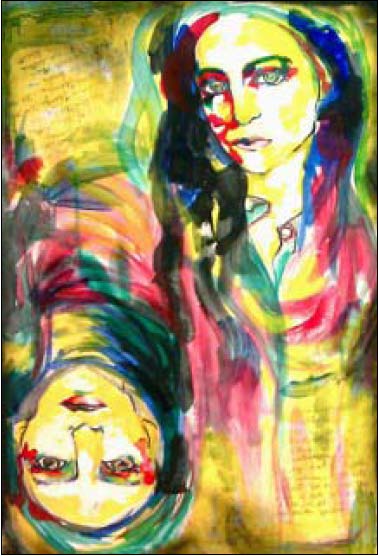 The Istanbul Center offers this educational experience for middle and high school students throughout the Southeast now! This year we had the wonderful opportunity to get our kids to think about “Empathy: Walking in Another’s Shoes” and the results from my students were powerful once again! Students were engaged in the process of learning and caring about others and the results of their art were incredible! This year our Suzie won first place in the Georgia competition AND first place in the Southeastern competition! I am so proud of the work that is coming out of my students when they are given lessons that force them to think outside of the box. I would like to personally thank the Istanbul Center for helping me push my students to be the best they can be while caring, appreciating and understanding others in our world!
The Istanbul Center offers this educational experience for middle and high school students throughout the Southeast now! This year we had the wonderful opportunity to get our kids to think about “Empathy: Walking in Another’s Shoes” and the results from my students were powerful once again! Students were engaged in the process of learning and caring about others and the results of their art were incredible! This year our Suzie won first place in the Georgia competition AND first place in the Southeastern competition! I am so proud of the work that is coming out of my students when they are given lessons that force them to think outside of the box. I would like to personally thank the Istanbul Center for helping me push my students to be the best they can be while caring, appreciating and understanding others in our world!
The more I think about the impact this lesson has on my students, the more I begin to form my ideas about where I want my dissertation to go as I work through my doctoral studies at the University of Georgia. I am now taking religion courses, along with my art education course work, and tying in faith with action learning, service learning projects, and character education curricula. The Istanbul Center promotes international awareness, creative problem solving, and critical thinking skills that are preparing students, our youth, to compete globally and become responsible citizens in an ever changing world. The visual arts can, and should, teach this as well. When we create curriculum that encourages our kids to think at these high levels, the art becomes more than another pretty picture, it can begin to change the world. Art with Purpose is formed from the philosophy created by the Istanbul Center!
The Middle East Institute (MEI) is an independent, non-partisan, non-for-profit, educational organization. It does not engage in advocacy and its scholars’ opinions are their own. MEI welcomes financial donations, but retains sole editorial control over its work and its publications reflect only the authors’ views. For a listing of MEI donors, please click here.













